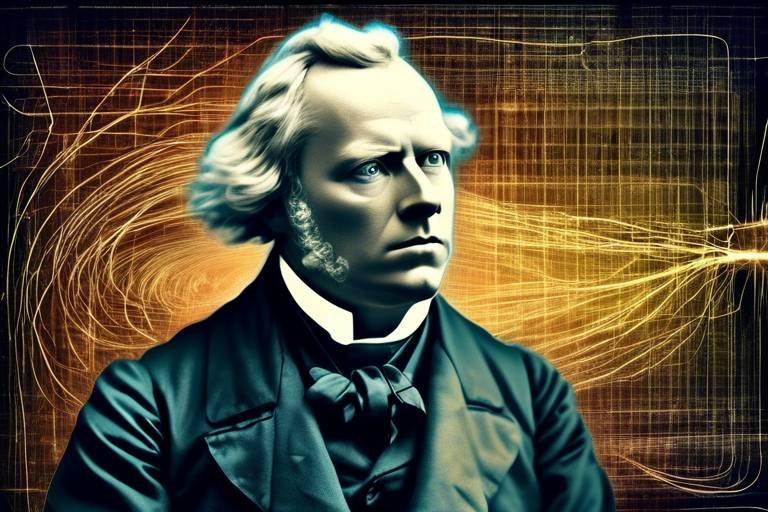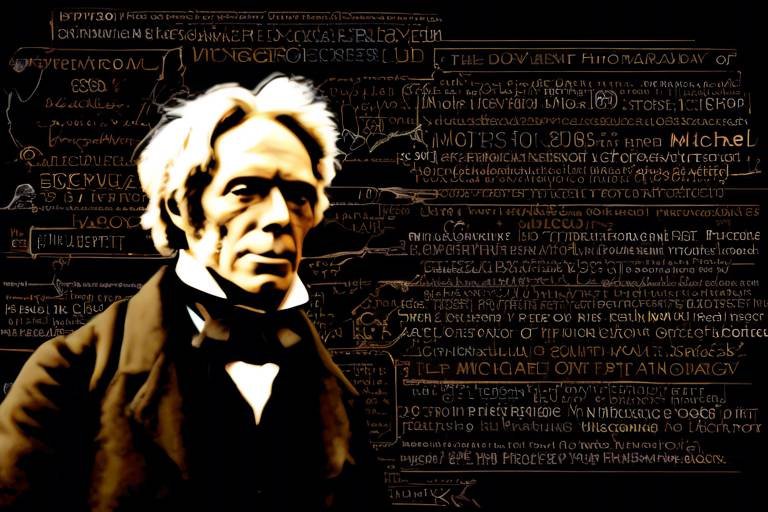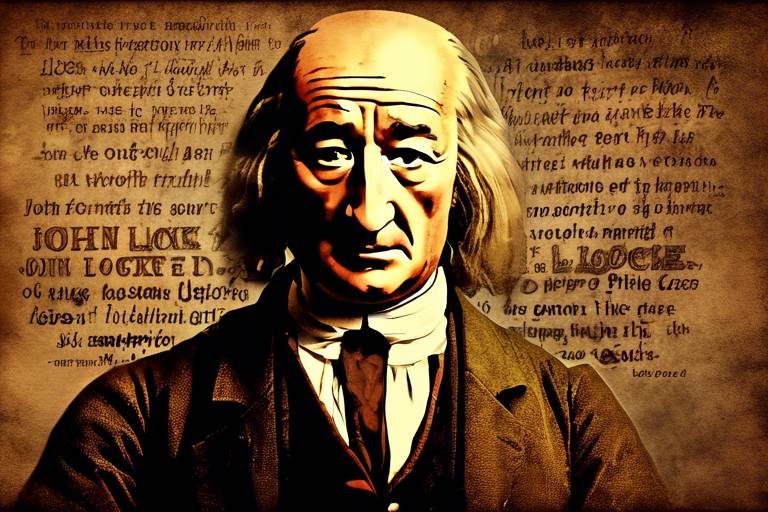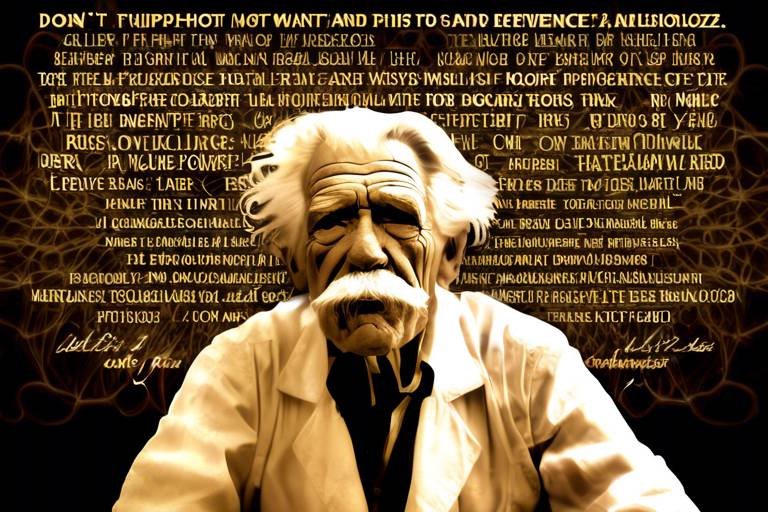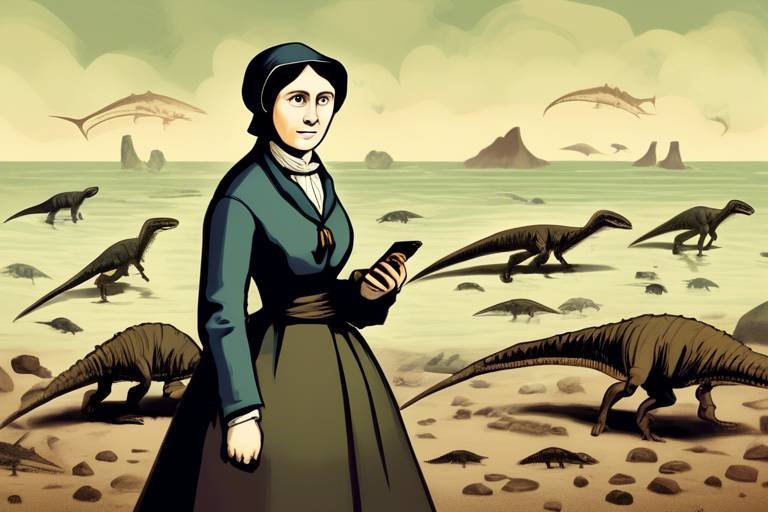The Discoveries of Emmeline Pankhurst and Women's Rights
Emmeline Pankhurst was not just a name in history; she was a force of nature who dedicated her life to the fight for women's rights. Born in 1858 in Manchester, England, her journey was fueled by a burning desire for social justice and equality. Pankhurst's contributions to the women's suffrage movement were monumental, and her discoveries about the power of activism and civil disobedience reshaped the landscape of gender equality. This article explores her impactful journey, the strategies she employed, and the legacy she left behind, which continues to inspire feminists around the globe today.
Emmeline's upbringing played a crucial role in shaping her views on women's rights. Growing up in a politically active family, she was exposed to discussions about social issues from a young age. Her mother, a strong advocate for women's education, instilled in her the belief that women deserved more than traditional roles. Education was a significant part of her early life, and Pankhurst attended the Manchester High School for Girls, where she developed a passion for learning and a sense of empowerment. These formative years were pivotal in igniting her passion for social justice, setting the stage for her future activism.
In 1903, Pankhurst founded the Women's Social and Political Union (WSPU), a groundbreaking organization that became the backbone of the suffrage movement. The WSPU aimed to secure voting rights for women through militant tactics and relentless campaigning. Under Pankhurst's leadership, the organization adopted the motto "Deeds, not words," emphasizing action over mere discussion. The WSPU's goals were clear: to raise public awareness, pressure politicians, and ultimately achieve the right to vote for women. The formation of this union marked a turning point in the fight for women's suffrage, as it united women from various backgrounds and social classes in a common cause.
One of the most controversial aspects of Pankhurst's activism was her adoption of militant tactics. The WSPU employed a range of strategies, from peaceful protests to more aggressive actions like window smashing and arson. While some viewed these tactics as extreme, they undeniably brought attention to the suffrage movement. The public's reaction was mixed; many were outraged, while others began to sympathize with the cause. Pankhurst believed that such drastic measures were necessary to break through the indifference of the government and society regarding women's rights. This period of activism can be likened to a lit match in a dark room, illuminating the urgent need for change.
Pankhurst and her followers faced imprisonment for their relentless activism, but instead of silencing them, it only fueled their determination. During their time in prison, many suffragettes, including Pankhurst, resorted to hunger strikes as a form of protest against their unjust treatment. These hunger strikes garnered significant media attention and public sympathy, turning the plight of the suffragettes into a national issue. The sight of women enduring such hardship for their rights was a powerful image that swayed public opinion and highlighted the need for change.
The media played a crucial role in shaping public perception of Pankhurst and the WSPU. Newspapers often portrayed them as radicals or even criminals, which sometimes backfired, drawing more attention to their cause. Journalists were both adversaries and allies; their coverage could ignite outrage or sympathy among the public. Pankhurst understood the importance of media in the fight for women's rights, using it as a tool to further the cause. The sensationalism surrounding their actions often served to amplify their message, making it clear that the fight for suffrage was far from over.
While Pankhurst was undoubtedly a key figure in the suffrage movement, she was not alone. Many other women played crucial roles alongside her. Figures like Emmeline's daughters, Christabel and Sylvia, and other notable suffragettes such as Millicent Fawcett and Annie Kenney contributed significantly to the cause. Their collaborations and differing strategies enriched the movement, showcasing a wide array of voices and tactics in the fight for women's rights. Each woman brought her unique perspective, creating a tapestry of activism that resonated across the nation.
Emmeline Pankhurst's work laid the foundation for future generations of feminists. Her relentless pursuit of equality and justice for women has left an indelible mark on history. Today, her legacy continues to inspire activists worldwide, reminding us that the fight for women's rights is ongoing. Pankhurst's ideas about activism, particularly her belief in the necessity of bold action, resonate in contemporary feminist movements. Her life serves as a powerful reminder that change is possible when women unite and demand their rights.
Pankhurst's strategies and ideas are still relevant in today's discussions about gender equality. Modern feminists draw inspiration from her courage and tenacity, reflecting on how her militant activism paved the way for the rights women enjoy today. The conversations surrounding women's rights have evolved, but the essence of Pankhurst's message remains: women must fight for their place in society, and sometimes that fight requires unconventional methods.
Emmeline Pankhurst's contributions are celebrated worldwide, with monuments, literature, and events dedicated to her memory. Statues in her honor stand in various locations, reminding us of her pivotal role in the suffrage movement. Books and films have been created to tell her story, ensuring that her legacy lives on. Each year, events are held to commemorate her achievements, inspiring new generations to continue the fight for women's rights.
- What was Emmeline Pankhurst's main contribution to women's rights?
Pankhurst's main contribution was her role in founding the WSPU and advocating for women's suffrage through militant activism. - How did Pankhurst's tactics influence public opinion?
Her militant tactics sparked debate and controversy, drawing attention to the women's suffrage movement and shifting public opinion in favor of women's rights. - What is Pankhurst's legacy today?
Pankhurst's legacy is seen in modern feminist movements, where her ideas about activism and equality continue to inspire new generations.

The Early Life of Emmeline Pankhurst
Emmeline Pankhurst was born on July 15, 1858, in the bustling city of Manchester, England. Growing up in a family that valued social justice, her childhood was steeped in the ideals of reform and equality. Her father, a successful businessman, and her mother, a passionate advocate for women's rights, instilled in her a sense of purpose from a young age. This nurturing environment ignited her passion for social justice and laid the groundwork for her future activism.
As a young girl, Pankhurst was deeply influenced by the social and political climate of her time. The late 19th century was a period of significant upheaval, with the industrial revolution transforming society. The stark inequalities faced by women, particularly in terms of education and employment, were glaringly evident. These early experiences would shape her worldview and motivate her to fight for change. Pankhurst's education at the local grammar school and later at the prestigious Manchester Technical College further broadened her horizons, exposing her to new ideas and the burgeoning feminist movements of the era.
In 1879, Emmeline married Richard Pankhurst, a barrister who was also a fervent supporter of women's suffrage. Their partnership was not just romantic; it was a meeting of minds. Together, they shared a vision for a more equitable society. Pankhurst's marriage provided her with a platform to engage with other activists and intellectuals, allowing her to deepen her understanding of the issues at hand. Richard's encouragement and support were instrumental in her development as a leader in the suffrage movement.
Throughout her early life, Pankhurst encountered various challenges that would later inform her approach to activism. The societal norms of the time often relegated women to subordinate roles, which fueled her determination to dismantle these barriers. She became increasingly aware of the injustices faced by women, particularly in their struggle for the right to vote. This awareness was not just a personal revelation; it was a call to action. Pankhurst's early experiences were the seeds from which her lifelong commitment to women's rights would grow.
In the late 1890s, Pankhurst began to actively participate in the suffrage movement, joining organizations that aimed to secure voting rights for women. Her experiences during this time were pivotal, as she witnessed firsthand the struggles and triumphs of her fellow activists. The camaraderie and shared purpose she found within these groups reinforced her belief that collective action was essential for achieving meaningful change.
Ultimately, the early life of Emmeline Pankhurst was characterized by a unique blend of privilege and purpose. While she enjoyed certain advantages as a member of the middle class, she was acutely aware of the limitations imposed on women in society. This duality fueled her passion for activism, leading her to become one of the most influential figures in the fight for women's rights. Her journey from a young girl in Manchester to a formidable leader in the suffrage movement is a testament to the power of early influences and the indomitable spirit of a woman determined to change the world.

The Formation of the Women's Social and Political Union
In the year 1903, a spark ignited that would change the course of history for women in the United Kingdom. This was the year Emmeline Pankhurst, alongside her daughters Christabel and Sylvia, founded the Women's Social and Political Union (WSPU). The WSPU emerged as a direct response to the slow progress of the suffrage movement and the widespread disenfranchisement of women. Pankhurst believed that the time had come for women to take a more assertive approach to their rights, and thus, the WSPU was born, with its motto, "Deeds, not words," encapsulating their revolutionary spirit.
The WSPU was established as a militant organization, aiming to draw attention to the injustices faced by women and to demand their right to vote. Unlike earlier suffrage groups, which often employed peaceful protests and petitions, the WSPU adopted a more aggressive stance. They organized rallies, marches, and demonstrations, which were often met with resistance from authorities. The WSPU's strategy was to create a sense of urgency and to provoke public discourse around women's rights. Their tactics included everything from window-smashing to arson, which, while controversial, undeniably brought the issue of women's suffrage to the forefront of national conversation.
At the heart of the WSPU's mission was a clear set of objectives. The organization aimed to:
- Secure the right to vote for women in the UK, believing that political power was essential for social change.
- Raise awareness about women's issues and the inequalities they faced in society.
- Mobilize women from all walks of life to join the movement, emphasizing that suffrage was not just a privilege for the wealthy.
The WSPU also introduced unique fundraising strategies, such as the sale of badges and the organization of events, which helped sustain their operations and spread their message. Their efforts attracted a diverse membership, including women from various social classes and backgrounds, united by a common goal: the fight for equality. This inclusivity was crucial in creating a broad coalition that would amplify their voice and influence.
However, the WSPU's militant tactics were met with criticism, both from the public and from other suffragist organizations. Many believed that such aggressive actions undermined the legitimacy of the suffrage movement. Yet, Pankhurst and her followers remained undeterred, believing that only through radical action could they achieve their goals. The WSPU's strategies sparked fierce debates about the nature of activism and the lengths to which one should go in the pursuit of justice.
In summary, the formation of the Women's Social and Political Union marked a pivotal moment in the struggle for women's rights in the UK. Emmeline Pankhurst's vision for a more assertive approach to suffrage galvanized a generation of women to stand up and demand their rights. The WSPU became a symbol of the fight for gender equality, and its legacy continues to inspire activists around the world today.
Q: What was the main goal of the Women's Social and Political Union?
A: The main goal of the WSPU was to secure the right to vote for women in the UK through militant activism.
Q: How did the public react to the WSPU's tactics?
A: The public had mixed reactions; some supported their cause, while others criticized their militant tactics as extreme.
Q: Who were the key figures in the WSPU?
A: Key figures included Emmeline Pankhurst, her daughters Christabel and Sylvia, and other prominent suffragettes like Annie Kenney and Emmeline Pethick-Lawrence.
Q: What legacy did the WSPU leave behind?
A: The WSPU laid the groundwork for future feminist movements and significantly advanced the conversation around women's rights and suffrage.

Militant Tactics and Their Impact
When we think about the suffrage movement, it’s hard not to picture the fierce determination of Emmeline Pankhurst and her followers. The militant tactics employed by the Women's Social and Political Union (WSPU) were revolutionary for their time and reshaped the landscape of activism. These tactics included everything from peaceful protests to more aggressive actions, like window smashing and arson. You might wonder, why did they adopt such extreme measures? The answer lies in the urgency of their cause. With women denied the right to vote, Pankhurst believed that only bold actions would capture the public's attention and force the government to take them seriously.
The WSPU’s strategies were not just random acts of rebellion; they were carefully planned to maximize impact. For instance, the organization often staged public demonstrations that attracted media coverage, ensuring that their message reached a wider audience. Imagine a crowd gathered in a bustling city, chanting for their rights, with reporters capturing every moment. This kind of visibility was crucial in a time when women’s voices were often silenced. Moreover, these demonstrations were designed to provoke a reaction from authorities, making it impossible for the government to ignore their demands.
However, the militant approach wasn’t without its critics. Many people, including some within the suffrage movement, believed that such tactics were too extreme and counterproductive. They argued that peaceful protests would be more effective in winning public sympathy. But Pankhurst and her allies were undeterred. They understood that sometimes, to achieve lasting change, one must be willing to challenge the status quo, even if it means stepping outside of societal norms.
As the movement gained momentum, the public's reaction varied widely. Some admired the courage of the suffragettes, while others were horrified by their methods. This division is reflected in the media coverage of the time. Newspapers often sensationalized the actions of the WSPU, portraying them as dangerous radicals. Yet, this negative portrayal also served to highlight the plight of women and brought their struggle into the national conversation. It’s fascinating to consider how Pankhurst’s militant tactics, while controversial, ultimately contributed to a broader awareness of women's rights.
The impact of these tactics can be seen in the eventual passage of the Representation of the People Act in 1918, which granted voting rights to women over 30. It’s almost poetic to think that the very actions that sparked outrage also paved the way for progress. The WSPU’s militant approach was a catalyst for change, igniting a fire that would inspire future generations of activists. In many ways, they were the trailblazers, showing that when faced with injustice, sometimes you have to make noise to be heard.
In summary, the militant tactics of the WSPU were a double-edged sword. While they polarized public opinion, they also brought significant attention to the suffrage movement. Pankhurst and her followers proved that activism could take many forms, and sometimes, the loudest voices are the ones that shake the foundations of society. As we reflect on their legacy, it’s essential to recognize that their courage and determination laid the groundwork for the rights we enjoy today.
- What were the main militant tactics used by the WSPU?
The WSPU employed a range of tactics including public demonstrations, window smashing, and hunger strikes to draw attention to their cause. - How did the public react to the militant tactics?
Reactions were mixed; some supported the suffragettes' bravery while others condemned their methods as extreme. - What was the outcome of these militant tactics?
The tactics helped raise awareness and ultimately contributed to the passing of the Representation of the People Act in 1918, granting voting rights to some women.

Prison and Hunger Strikes
Emmeline Pankhurst and her fellow suffragettes faced significant challenges as they fought for women's rights, and one of the most profound aspects of their struggle was their willingness to endure imprisonment and engage in hunger strikes. These acts were not just personal sacrifices; they were powerful statements that drew public attention to the injustices faced by women in their quest for the right to vote. The prison experience was brutal, and many women were subjected to harsh conditions that reflected society's disdain for their cause.
When Pankhurst was arrested, she and her fellow activists would often resort to hunger strikes as a form of protest against their treatment and the lack of recognition for their demands. This tactic was not merely a desperate measure; it was a calculated strategy designed to elicit sympathy from the public and to force the government to take notice of their plight. The hunger strikes garnered significant media coverage, which helped to shift public perception of the suffragette movement.
The public was often torn between admiration for the suffragettes' courage and horror at the government's response. Many women went on hunger strikes, and in response, authorities would sometimes resort to force-feeding, a procedure that was both physically painful and psychologically traumatic. This brutal practice sparked outrage among the public and created a wave of sympathy for the suffragettes, as people began to see them not just as radicals, but as women fighting for their basic rights.
Here’s a brief overview of the impact of prison and hunger strikes on the suffrage movement:
| Impact | Description |
|---|---|
| Increased Public Awareness | The media coverage of hunger strikes brought national attention to the suffrage movement. |
| Shift in Public Perception | Women were seen as martyrs for their cause, garnering sympathy and support. |
| Government Response | The brutality of force-feeding led to public outrage and pressure on the government to address women's rights. |
Despite the physical and emotional toll, the hunger strikes were instrumental in advancing the cause of women's suffrage. They highlighted the extreme lengths to which women were willing to go to secure their rights and challenged the prevailing attitudes of the time. Pankhurst and her followers turned their suffering into a rallying cry, igniting a fire in the hearts of many who believed in equality.
In the end, the sacrifices made during these hunger strikes were not in vain. They paved the way for future generations to continue the fight for gender equality and inspired countless individuals to stand up against injustice. The legacy of these brave women remains a powerful testament to the strength and resilience of those who dare to challenge the status quo.

Public Perception and Media Coverage
The relationship between media coverage and public perception of Emmeline Pankhurst and the Women's Social and Political Union (WSPU) was complex and often tumultuous. During the early 20th century, newspapers were the primary source of information for the public, and they wielded significant power in shaping opinions. Pankhurst, with her bold and often militant tactics, captured the attention of the press, but not always in a favorable light. The sensationalism of her actions—such as protests, vandalism, and hunger strikes—often led to a mix of admiration and disdain from the public.
Initially, many newspapers portrayed Pankhurst and her followers as radicals or even hysterical women who were disrupting the social order. This negative framing was not uncommon; the media often leaned into stereotypes that undermined the seriousness of their cause. However, as the suffrage movement gained momentum, the narrative began to shift. The public started to recognize the determination and courage of these women, especially as stories of their imprisonment and hunger strikes emerged. These acts of defiance drew sympathy and support, transforming Pankhurst into a symbol of the struggle for women's rights.
To illustrate the changing public perception over time, consider the following table that summarizes key events and their media portrayal:
| Event | Media Portrayal | Public Reaction |
|---|---|---|
| Formation of WSPU (1903) | Initial skepticism, labeled as radicals | Mixed reactions; some support, but many opposed |
| Hunger Strikes (1910s) | Sympathetic coverage highlighting bravery | Increased public support and outrage over treatment |
| Cat and Mouse Act (1913) | Criticism of government tactics, media outrage | Widespread condemnation of government actions |
Moreover, the WSPU's use of public demonstrations and media stunts played a crucial role in garnering attention. Pankhurst understood the importance of publicity and often orchestrated events that would attract journalists. This strategic approach not only highlighted their cause but also put pressure on politicians to respond. The WSPU's innovative use of posters, leaflets, and public speeches ensured that their message reached a wide audience, further embedding their struggle into the public consciousness.
In conclusion, the media's portrayal of Emmeline Pankhurst and the WSPU was a double-edged sword. While it initially cast them in a negative light, the relentless activism and sacrifices of these women gradually changed the narrative. Over time, they became symbols of courage and resilience, inspiring not only their contemporaries but also future generations in the ongoing fight for gender equality.
- Who was Emmeline Pankhurst?
Pankhurst was a British political activist and leader of the suffragette movement, which fought for women's right to vote. - What was the WSPU?
The Women's Social and Political Union was an organization founded by Pankhurst in 1903 to promote women's suffrage through militant tactics. - How did the media influence the suffrage movement?
The media played a critical role in shaping public perception of the suffragettes, often oscillating between ridicule and admiration. - What impact did Pankhurst's activism have?
Pankhurst's work significantly advanced the women's rights movement and laid the groundwork for future feminist efforts.

The Role of Other Suffragettes
While Emmeline Pankhurst is often recognized as the face of the women's suffrage movement, it's crucial to acknowledge that she was not alone in this fight. The struggle for women's rights was a collective effort, and many other suffragettes played pivotal roles alongside her. These women, each with their unique backgrounds and approaches, contributed significantly to the movement's momentum and success.
One of the most notable figures was Emmeline's daughter, Christabel Pankhurst. She was not only a co-founder of the Women's Social and Political Union (WSPU) but also a brilliant strategist. Christabel was instrumental in organizing many of the WSPU's most audacious campaigns, including the infamous window-smashing protests. Her charisma and public speaking ability helped to rally support and energize the movement.
Another key player was Millicent Fawcett, who led the National Union of Women's Suffrage Societies (NUWSS). Unlike the WSPU, which adopted militant tactics, Fawcett's approach was more moderate and focused on peaceful advocacy. She believed in working through legal channels to achieve suffrage, emphasizing the importance of education and persuasion over confrontation. This contrast between her and Pankhurst's strategies highlights the diversity of thought within the movement.
Moreover, we cannot overlook the contributions of women like Emmeline Pankhurst's sister, Sylvia Pankhurst. Sylvia was a passionate advocate for working-class women and often criticized the WSPU for neglecting the needs of poorer women. She founded the East London Federation of Suffragettes, focusing on social issues such as housing and labor rights. Her efforts remind us that the fight for women's rights was intertwined with broader social justice issues.
Additionally, numerous unsung heroes, such as Florence Nightingale, played supportive roles, using their influence to promote the cause. Nightingale, famed for her nursing during the Crimean War, lent her voice to the suffrage movement, advocating for women's rights in her own field. The collective efforts of these women created a powerful force that could not be ignored.
In summary, the suffrage movement was a tapestry woven from the threads of many women's experiences and ideologies. Each suffragette brought her own perspective and passion to the cause, creating a rich and diverse movement. Emmeline Pankhurst may have been a central figure, but the success of the women's suffrage movement was undoubtedly a collaborative effort, showcasing the strength and resilience of women united for a common goal.
- Who was Emmeline Pankhurst?
Emmeline Pankhurst was a British political activist and leader of the suffragette movement, advocating for women's right to vote in the early 20th century. - What is the WSPU?
The Women's Social and Political Union (WSPU) was an organization founded by Emmeline Pankhurst in 1903 to promote women's suffrage through militant tactics. - How did other suffragettes contribute to the movement?
Other suffragettes, like Christabel Pankhurst and Millicent Fawcett, played vital roles with different strategies, from militant activism to peaceful advocacy, enriching the fight for women's rights. - What is the legacy of the suffragette movement today?
The suffragette movement laid the groundwork for modern feminist movements, inspiring ongoing efforts for gender equality worldwide.

The Legacy of Emmeline Pankhurst
Emmeline Pankhurst's legacy is nothing short of monumental. She didn’t just fight for women’s rights; she ignited a revolution that transformed societal norms and reshaped the political landscape of her time. Her relentless pursuit of equality laid the groundwork for future generations of feminists, making her a beacon of hope and inspiration. Imagine a world where women were silenced, their voices unheard, and then picture the thunderous roar of change that Pankhurst and her fellow suffragettes brought forth. It’s a powerful image, isn't it?
One of the most significant aspects of Pankhurst's legacy is her ability to galvanize women from all walks of life. She understood that the fight for suffrage was not just about voting rights; it was about dismantling the patriarchal structures that oppressed women. By rallying women together through the Women's Social and Political Union (WSPU), she created a formidable force that demanded change. This collective action is a crucial lesson in activism today—when women unite, they can challenge the status quo and effect real change.
Furthermore, Pankhurst's strategies, though often controversial, opened the door for more radical approaches to activism. The militant tactics employed by the WSPU, including protests, civil disobedience, and hunger strikes, showcased a level of determination that was previously unseen. These methods not only drew attention to the suffrage movement but also forced society to confront the injustices faced by women. Today, we see echoes of her tactics in various social movements around the globe, proving that her influence transcends time and geography.
In the context of modern feminism, Pankhurst's ideas continue to resonate. Her belief that women should have a voice in political matters remains a cornerstone of feminist discourse. The ongoing struggles for gender equality, reproductive rights, and workplace equity can all trace their roots back to the foundations laid by Pankhurst and her contemporaries. It’s as if she planted seeds of change that have flourished into a vast garden of activism, each flower representing a different facet of women’s rights.
Moreover, Pankhurst's legacy is celebrated and commemorated in various forms around the world. From statues that stand in her honor to literature that recounts her life and struggles, her contributions are recognized as integral to the fight for women's rights. For example, the Pankhurst Centre in Manchester serves as a museum and a hub for feminist activism, ensuring that her story continues to inspire new generations. In addition, numerous events and educational programs are dedicated to her memory, emphasizing the importance of her work in today’s context.
To encapsulate her enduring legacy, we can look at the following table, which highlights some key aspects of Pankhurst’s impact:
| Aspect | Description |
|---|---|
| Political Change | Her activism played a crucial role in women gaining the right to vote in the UK in 1918. |
| Militant Tactics | Innovative protest methods that challenged societal norms and drew public attention. |
| Inspiration | Continues to inspire feminist movements worldwide, influencing strategies and ideologies. |
| Commemoration | Numerous statues, literature, and events celebrate her life and contributions. |
In conclusion, Emmeline Pankhurst's legacy is not just a chapter in history; it’s an ongoing narrative that continues to evolve. As we navigate the complexities of gender equality today, her story serves as a reminder of the power of resilience and the importance of standing up for what is right. The fight for women's rights is far from over, but thanks to pioneers like Pankhurst, we are armed with the lessons of the past, fueling our determination to build a more equitable future.
- What were Emmeline Pankhurst's main contributions to the women's rights movement?
Pankhurst founded the WSPU, advocated for women's suffrage, and employed militant tactics to draw attention to the cause.
- How did Pankhurst's tactics influence modern feminism?
Her aggressive strategies showcased the effectiveness of direct action, which continues to inspire contemporary movements for gender equality.
- What is the significance of Pankhurst's legacy today?
Her legacy serves as a foundation for ongoing struggles for women's rights, reminding us of the importance of activism and collective action.

Influence on Modern Feminism
Emmeline Pankhurst's influence on modern feminism is nothing short of monumental. Her fierce dedication to women's rights and her innovative activism methods have paved the way for contemporary feminists around the globe. Imagine a spark igniting a flame; that's what Pankhurst did for the women's rights movement. She didn't just fight for the right to vote; she challenged societal norms and expectations, urging women to stand up and be heard. Today, her legacy resonates in various feminist movements that continue to advocate for gender equality.
One of the most striking aspects of Pankhurst's influence is her ability to galvanize women into action. She understood that collective effort could bring about significant change. Modern feminist movements echo this sentiment, emphasizing the importance of solidarity among women. Whether it's through marches, social media campaigns, or grassroots organizing, the spirit of unity that Pankhurst championed remains alive and well. For instance, movements like #MeToo and Time's Up have mobilized countless individuals and highlighted the power of shared experiences in combating systemic injustices.
Furthermore, Pankhurst's militant tactics, although controversial, have inspired a range of strategies in today's activism. While some feminists may advocate for peaceful protests and dialogue, others draw from Pankhurst's playbook, employing direct action and civil disobedience to draw attention to pressing issues. This duality reflects the diverse landscape of modern feminism, where various approaches coexist to address the multifaceted nature of gender inequality.
Another pivotal aspect of Pankhurst's legacy is her emphasis on intersectionality, albeit in a nascent form. While she primarily focused on white, middle-class women's suffrage, her advocacy laid the groundwork for future feminists to expand the conversation to include race, class, and sexuality. Today, intersectional feminism seeks to understand how various social identities intersect and impact a person's experience of discrimination. This evolution of thought is crucial in ensuring that all women's voices are heard and valued, a principle that Pankhurst would likely champion if she were alive today.
Moreover, the commemorations and recognition of Pankhurst's contributions serve as a reminder of the ongoing struggle for women's rights. Statues, literature, and educational programs dedicated to her life and work keep her spirit alive. They not only honor her achievements but also inspire new generations of feminists to continue the fight. As we reflect on her impact, it's essential to acknowledge that modern feminists stand on the shoulders of giants like Pankhurst. Her courage and tenacity remind us that while progress has been made, the journey toward true gender equality is far from over.
In summary, Emmeline Pankhurst's influence on modern feminism is profound and enduring. Her strategies, emphasis on solidarity, and the initial steps toward intersectionality have shaped the feminist discourse we see today. As we continue to advocate for women's rights, let us carry forward her legacy, ensuring that the fight for equality remains vibrant and relentless.
- What were Emmeline Pankhurst's main contributions to the women's rights movement?
Pankhurst founded the Women's Social and Political Union (WSPU) and was a key figure in advocating for women's suffrage through militant tactics. - How did Pankhurst's tactics influence modern feminist movements?
Her use of direct action and civil disobedience inspired contemporary feminists to adopt similar strategies in their advocacy for gender equality. - What is the significance of intersectionality in feminism today?
Intersectionality recognizes that various social identities intersect, impacting individuals' experiences of discrimination, thus broadening the feminist movement to be more inclusive. - How is Emmeline Pankhurst commemorated today?
Pankhurst is honored through statues, literature, and educational programs that celebrate her contributions to the women's rights movement.

Commemoration and Recognition
Emmeline Pankhurst's contributions to the women's rights movement are not just historical footnotes; they are celebrated and commemorated in various forms around the globe. Her tireless activism has inspired countless movements and individuals, and her legacy is honored in many significant ways. From statues to literature, her impact is vividly alive in contemporary society.
One of the most prominent forms of recognition is the numerous monuments dedicated to her memory. For example, the statue of Emmeline Pankhurst located in Manchester, England, serves as a powerful symbol of the struggle for women's suffrage. Unveiled in 2018, this statue not only honors Pankhurst but also stands as a reminder of the ongoing fight for gender equality. The statue depicts her in a dynamic pose, capturing her spirit and determination, making it a focal point for activists and tourists alike.
In addition to physical monuments, Pankhurst's legacy is preserved in literature and education. Many authors have chronicled her life and work, providing insights into her strategies and the broader suffrage movement. Books such as "Emmeline Pankhurst: A Biography" offer detailed accounts of her journey, while educational programs in schools often include her story as a vital part of history lessons on women's rights. This ensures that new generations understand the significance of her contributions and the importance of continuing the fight for equality.
Moreover, various events and celebrations take place annually to honor her memory. For instance, International Women's Day on March 8th often features discussions and events that highlight Pankhurst's influence on modern feminism. These gatherings not only commemorate her achievements but also encourage ongoing dialogue about women's rights and the progress still needed.
Furthermore, Pankhurst's impact is recognized through awards and honors named after her, celebrating women who exemplify her spirit of activism. The Emmeline Pankhurst Award is presented to individuals or organizations that have made significant contributions to advancing women's rights, thereby keeping her legacy alive in the present day.
In summary, Emmeline Pankhurst is commemorated through various means, from statues and literature to awards and annual events. Each of these recognitions serves not only to honor her memory but also to inspire future generations to continue the fight for gender equality. Her story is a powerful reminder of the importance of activism and the impact one individual can have on the world.
- What was Emmeline Pankhurst known for?
Pankhurst was a leading figure in the women's suffrage movement in the UK, advocating for women's right to vote through activism and the formation of the Women's Social and Political Union (WSPU). - How did Pankhurst's tactics differ from other suffragists?
Pankhurst adopted more militant tactics compared to other suffragists, including protests, hunger strikes, and civil disobedience, which drew significant public attention to the cause. - Are there any monuments dedicated to Emmeline Pankhurst?
Yes, there are several monuments, including a notable statue in Manchester, England, which honors her contributions to the women's rights movement. - How is Pankhurst's legacy remembered today?
Pankhurst's legacy is celebrated through literature, educational programs, annual events, and awards that recognize individuals contributing to women's rights.
Frequently Asked Questions
- Who was Emmeline Pankhurst?
Emmeline Pankhurst was a prominent British suffragette and political activist known for her role in the women's rights movement. She founded the Women's Social and Political Union (WSPU) in 1903, which was crucial in advocating for women's voting rights.
- What were Pankhurst's main contributions to women's rights?
Pankhurst's main contributions included organizing campaigns for women's suffrage, employing militant tactics to draw attention to the cause, and inspiring countless women to join the movement. Her leadership and determination significantly advanced the fight for gender equality.
- What tactics did the WSPU use to promote women's suffrage?
The WSPU, under Pankhurst's leadership, used a variety of tactics, including protests, marches, and civil disobedience. They often resorted to militant actions, such as window smashing and hunger strikes, to gain public attention and pressure the government for change.
- How did the public react to the militant tactics of the suffragettes?
The public reaction was mixed; while some supported the suffragettes' cause, others viewed their militant tactics as extreme and disruptive. Media coverage played a significant role in shaping public perception, often sensationalizing their actions.
- What role did hunger strikes play in the suffrage movement?
Hunger strikes became a powerful form of protest for Pankhurst and her followers. By refusing food while imprisoned, they aimed to draw attention to their plight and the injustices faced by women, ultimately swaying public opinion in favor of their cause.
- How did Emmeline Pankhurst influence modern feminism?
Pankhurst's ideas and strategies continue to resonate within contemporary feminist movements. Her emphasis on activism, direct action, and the importance of women's voices has shaped ongoing discussions around gender equality and women's rights today.
- What is Pankhurst's legacy today?
Emmeline Pankhurst's legacy is celebrated worldwide through monuments, literature, and events dedicated to her memory. She is recognized as a key figure in the fight for women's rights, inspiring future generations of feminists to continue advocating for equality.




